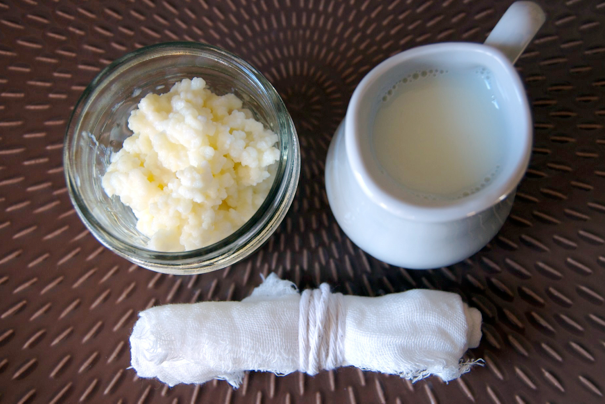
Ingredients:
live kefir grains (a tablespoon or more)
1 quart milk
cheese cloth or dish towel
clean 1/2 pint jar
clean quart jar
Instructions:
Take your live kefir grains and place them in a clean 1/2 pint glass jar or non-reactive container. Cover with milk, leaving at least a 1/2 inch head space at the top, since sometimes the mixture expands from the bubbles. Cover the jar with a clean piece of cloth and tie with a string or rubber band. The kefir will release gases, so don’t seal it up to tight. Let the mixture stand 24 hours on the counter top.
The next day, check your small batch of kefir. The mixture should be thickened and may have separated into a raft of grains and curds with whey beneath. This is a good thing. Smell it. It should smell sweet, sour and yeasty, like milky fresh bread from the oven. If not much has happened, let it sit on the counter one more night and check it again. If it still hasn’t thickened or smells bad, you might have dead grains. Get some fresh ones and try it again. If all is well, proceed to step 2.
Take the whole small batch and put it in a clean glass quart jar. Top with more milk and stir well, this time leaving at least an inch of head space. Cover with cheese cloth and leave out over night. The next day, stir the kefir, then give it a taste. Some folks like a very mild kefir milk, others like it very sour and yeasty. Since I use mine mostly for baking, I like the strong kind. Leave it out another day or so for a stronger batch. Timing will also depend on how active your grains are, and how many you have. Mine are so active now that one night is enough to make a strong batch. If you like how it tastes, proceed to step 3.
Strain the kefir milk through a mesh strainer to filter out the kefir grains. It’s OK if curds are still clinging to the grains. Top the strained milk with a 2 piece canning lid (these can burp if gas builds up) and put it in the refrigerator where it will last several weeks. Don’t be surprised if it’s quite bubbly when you use or drink it. Transfer the grains to another 1/2 pint jar, and recover with milk. If you don’t intend to make more kefir, you can cover it and put it in the refrigerator. It will slow down the bacterial action, but the grains should last a couple of weeks before you need to revive them on the countertop, then it’s back to step one.